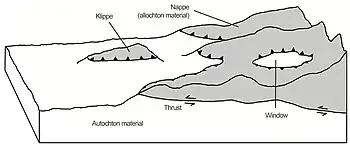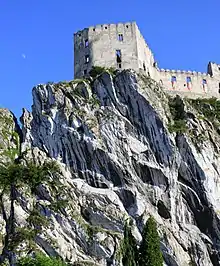Klippe
A klippe (German for cliff or crag) is a geological feature of thrust fault terrains. The klippe is the remnant portion of a nappe after erosion has removed connecting portions of the nappe. This process results in an outlier of exotic, often nearly horizontally translated strata overlying autochthonous strata.[1]

Schematic overview of a thrust system. The shaded material is called a nappe. The erosional hole is called a window or fenster. The klippe is the isolated block of the nappe overlying autochthonous material.

Beckov Castle, Slovakia, perched on a limestone klippe
Examples
- Chief Mountain, Montana
- Mount Yamnuska, Alberta
- The Rock of Gibraltar
- Acropolis of Athens, Greece
Klippes may also be found in the Pre-Alps of Switzerland and some of the isolated mountains in Assynt, Sutherland, in NW Scotland.[2]
References
- DiPietro, Joseph A. (December 21, 2012). Landscape Evolution in the United States: An Introduction to the Geography, Geology, and Natural History. Newnes. p. 343. ISBN 9780123978066. Retrieved 10 February 2016.
- Whittow, John (1984). Dictionary of Physical Geography. London: Penguin, 1984, p. 294. ISBN 0-14-051094-X.
This article is issued from Wikipedia. The text is licensed under Creative Commons - Attribution - Sharealike. Additional terms may apply for the media files.